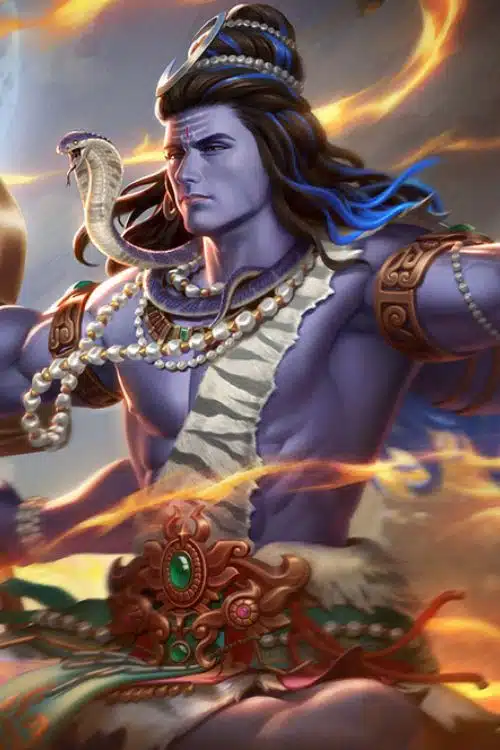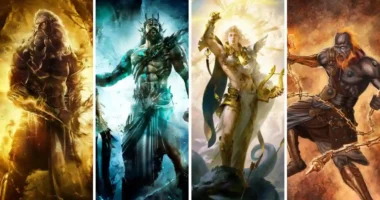3 Hindu gods also known as Trimurti | Brahma (creator) | Vishnu (preserver) | Mahesh (destroyer) | Explained: Hindu Mythology comprises various stories from different Hindu texts, including the four Vedas, Rigveda, Samaveda, Yajurveda and Atharva Veda, the Mahabharata, Ramayanam the Puranas, etc. These stories consist of various characters and Gods within them. It is said that the Hindu mythology and stories have a total of 33 crore Gods. These Gods are independently worshipped, or worshipped in groups within the Hindu religion. Some communities have certain Gods that they worship more than other Gods.
The main three Gods or the big three Gods of these Hindy stories and myths are known as the Trimurti. Trimurti is a Sanskrit term that directly translates to “three heads” in English. These are three separate Gods that are depicted together in one body with three different heads. The earliest recorded proof of these Gods was seen in the 4th or the 5th Century BC in Kalidasa’s poem Kumarasambhava, which translates to “Birth of the God of War” or “Birth of the War God”.
These three Gods are associated with the creation, preservation, and destruction of the world. The Gods are called Brahma, Vishnu, and Mahesh.
3 Hindu gods also known as Trimurti | Brahma (creator) | Vishnu (preserver) | Mahesh (destroyer) | Explained
Brahma (Creator)

Brahma is said to be the creator of the universe. In Sanskrit, the word for the universe is also “Brahman”, named after him. He is associated with the Vedas and knowledge. In some texts like the Puranas, he is shown to depict himself in a golden embryo-like fruit called Hiranyagarbha. In the Vedic era, Brahma was also closely associated with the Vedic God, Prajapati. Prajapati was also known to be the creator and the protector of the universe. However, Brahma is only said to be the creator of the universe. After the Vedic period, which is known as the post-Vedic era, Brahma was worshipped. By the 7th Century, it is said that he lost popularity. Some theorize it was because of a lie, while some say that it was only because people started worshipping the other Gods and Devis more.
He is often depicted with four heads and hands, and a long white beard. His four heads are said to represent the four Vedas, and they face the four directions of the world, the North, South, East, and West. He is said to have created his sons from his mind, hence they are referred to as Manasputras (Manas refers to mind and Putras means children or sons). There are scarce temples of worship for Brahma in India. One of the most popular ones is located in Pushkar, Rajasthan.
Vishnu (Preserver)

Vishnu is believed to be the preserver and the protector of the universe. He is the God that is currently looking after the universe. His name is derived from the Sanskrit word Visnu, which means “the pervader”. He is also known as Narayana or Hari. In some traditions and stories, Vishnu is said to be the preserver of the universe, while in some, Devi or a Goddess is regarded as a protector, while Lord Vishnu is said to be a part of the Trimurti. In stories and myths, he is often shown with his consort, Goddess Lakshmi (also spelt Laxmi), who is the Goddess of wealth and money. She is regarded as an equal of Lord Vishnu, and he is also known as Lakshmikanta (Kanta is the husband in Sanskrit).
Lord Vishnu is said to have a total of ten known avatars or incarnations. Amongst the ten, Lord Krishna and Lord Rama are the most well-known ones. In art, he is depicted with a blue or a black skin tone, often resting on a snake called Shesha, with Goddess Lakshmi sitting near him. He is shown to have four hands, with one of the hands holding a conch.
Mahesh (Shiva) (Destroyer)

Mahesh is an alternative name for Shiva, who is known as the destroyer of the universe. He is also regarded as the “God of all Gods”, or the “Great God”, etc. Lord Shiva is considered to be an amalgamation of various Vedic as well as non-Vedic deities and Gods. There is some complete non-Vedic origination of him as well. There are some sources that state that the word Shiva means “the auspicious one”, while some say that it is derived from the Tamil word for “red”.
Lord Shiva is depicted with blue skin tone, or sometimes with a blue spot on the throat. This is supposed to be an aftereffect of him swallowing poison. He is seen with a snake around his neck, the Moon on his hair, and the river flowing from his hair. His wife is Goddess Parvati, and he had two sons, Lord Ganesha and Lord Kartikeya. He is worshipped all across the countries in many ways. Some devotees perform a dance ritual called “Tandava” which is said to be Lord Shiva’s dance form. There are many temples and places of worship for him. Some of the popular ones in India are Amarnath, Somnath, etc.
Also Read: How to Decide Faster – Top 6 Decision-Making Skills





